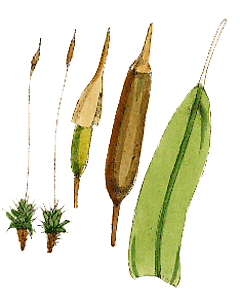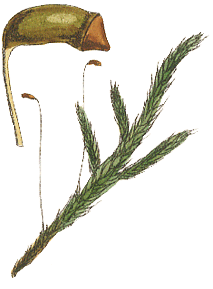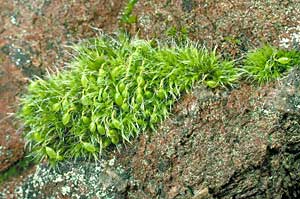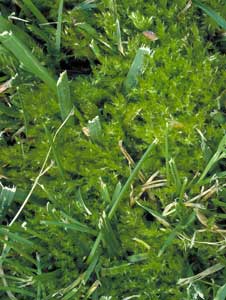
Ecology - Habitats
Urban bryophytes in Canberra
Many bryophyte species can be found in urban areas and such areas provide a great variety MICRO-HABITATS. Bryophytes in urban areas face some of the same challenges encountered by bryophytes in wilderness areas, but also ones that are quite different – gases from automobile exhausts, industrial pollutants, garden fertilizers, herbicides, soil compaction by vehicles parking or driving on unpaved areas and soil disturbances (for reasons such as construction work or cable laying). This list of urban challenges is by no means exhaustive.
No two of the world's urban centres are the same. They vary greatly in features such as size, population density, pollution and climate. Not surprisingly there is variation in the world's urban bryophytes, though some species seem to be found in almost any urban centre. It would be pointless to try to give some sort of summary of all the world's urban bryophytes. If you use a phrase such as "urban bryophytes" or "urban mosses" in an internet search engine you'll get more information about the urban species in various parts of the world.
Apart from the box on the right this page will restrict itself to some of the urban bryophytes found in the city of Canberra in which I live. The examples on this page don't constitute an exhaustive list of Canberra's urban bryophytes but have been chosen simply to introduce you to a variety of urban bryophytes as well as some of their habitats. Within the city of Canberra there are some areas of remnant native bushland, but those are ignored on this page, as are the grounds of the Australian National Botanic Gardens.
Breweries & bryophytesNot in Canberra - but an interesting industrial habitat! The aquatic moss Leptodictyum riparium has been found thriving in the soup-like brew of brewery effluent in England. The species also turns up in sewage filter beds.
|
Canberra has a population of about 325,000 people. The city has no heavy industry and is somewhat decentralised, there being several "town centres" rather than one large central business district. For the most part the city has an elevation of between about 500 and 600 metres, though within the city boundaries there are two non-urbanised hilltops with summits a little over 800 metres above sea level. Canberra is about 120 kilometres inland and has dry, continental climate with warm to hot summers and cool winters. The mean daily maximum temperature in January is 27.7°C and in July it is 11.2°C. The mean daily minimum temperatures are 13° C (January) and -0.2°C (July). The extreme recorded temperatures have been 42.2°C on 1st February 1968 (followed closely by 41.4°C on the previous day) and −10.0°C on 11th July 1971. The average annual rainfall is 629 mm, with an average of 108 rain days per year. Rainfall is spread reasonably evenly through the year, with October the wettest month (65.3 mm) and June the driest (39.6 mm). Canberra's inland location gives the city a fairly low relative humidity. This climate information has been taken from the Canberra page of the Bureau of Meteorology website and you can find more details there.
This page is divided into three sections. The first deals with open areas where, on sunny days, the bryophytes would be exposed to direct sunlight for a very large part of each day. The second deals with areas where there is some protection from long exposure to direct sun, for example by means of overhead tree cover. The third will give some examples of bryophytes found in much more protected areas. The three are useful as broad habitat categories but the borders between them are not sharply defined and some of the species mentioned will be found in habitats of more than one category.
Exposed, baked habitats
Exposed horizontal surfaces such as paved areas and roadside edges of compacted soil, mostly bare of vascular plants, are common in urban areas and Canberra is no exception. Such habitats are typically exposed to sun or wind for many hours each day and dry out readily, yet still support a variety of bryophytes. The cosmopolitan moss Bryum argenteum is common in many urban areas. In Canberra it is fairly common on exposed soil but also at road edges, especially at the junction of bitumen road and concrete gutter. Here ![]() is a photograph showing the upper surface of part of a colony of Bryum argenteum and here
is a photograph showing the upper surface of part of a colony of Bryum argenteum and here ![]() is a side view of part of the same colony. This colony was growing at the bitumen-concrete junction of a major road next to a bus interchange in the Canberra suburb of Belconnen. Numerous diesel-powered buses drove over this colony each day and there would also have been heavy passing traffic of cars and trucks. Yet this species was well-established at that site. Roof gutters are another Bryum argenteum habitat in Canberra. House roofs capture a large amount of fine dust which is washed into gutters by rain and, in the gutters, the dust may form a thin soil layer on which Bryum argenteum colonies develop.
is a side view of part of the same colony. This colony was growing at the bitumen-concrete junction of a major road next to a bus interchange in the Canberra suburb of Belconnen. Numerous diesel-powered buses drove over this colony each day and there would also have been heavy passing traffic of cars and trucks. Yet this species was well-established at that site. Roof gutters are another Bryum argenteum habitat in Canberra. House roofs capture a large amount of fine dust which is washed into gutters by rain and, in the gutters, the dust may form a thin soil layer on which Bryum argenteum colonies develop.
Gigaspermum repens ![]() , Goniomitrium acuminatum
, Goniomitrium acuminatum ![]() and Pleuridium nervosum
and Pleuridium nervosum ![]() are three more examples of mosses that can be found in exposed areas on largely bare, sun-baked soil in Canberra. These three are very low-growing mosses with a tufty growth habit and a number of other mosses with the same growth habits are found in similar urban habitats.
are three more examples of mosses that can be found in exposed areas on largely bare, sun-baked soil in Canberra. These three are very low-growing mosses with a tufty growth habit and a number of other mosses with the same growth habits are found in similar urban habitats.
In Canberra the thallose liverwort Asterella drummondii is found on soil in a variety of habitats, from somewhat sheltered to quite exposed. This photo ![]() shows some moist, green, strap-like thalli of this liverwort. The next photo
shows some moist, green, strap-like thalli of this liverwort. The next photo ![]() shows the same scene, but now much drier and with the margins of each thallus having rolled in towards the long central axis of the thallus. Those two photos were taken in an open area, a little off the road, opposite the main entrance to the Australian National Botanic Gardens. The simple thallose liverwort Sphaerocarpos texanus
shows the same scene, but now much drier and with the margins of each thallus having rolled in towards the long central axis of the thallus. Those two photos were taken in an open area, a little off the road, opposite the main entrance to the Australian National Botanic Gardens. The simple thallose liverwort Sphaerocarpos texanus ![]() and species of thallose liverwort in the genus Riccia are also found in expanses of largely bare soil. Sphaerocarpos has been found only a few times in Canberra but, as a genus Riccia is very common and about ten species are found in the city, some of the ten far more commonly than the others.
and species of thallose liverwort in the genus Riccia are also found in expanses of largely bare soil. Sphaerocarpos has been found only a few times in Canberra but, as a genus Riccia is very common and about ten species are found in the city, some of the ten far more commonly than the others.
Rock or brick walls around carparks are examples of non-horizontal exposed urban habitats and several species of moss are found at such sites. Species of Grimmia are perhaps the most commonly noticed, growing in cushion-like colonies, grey-green when dry and brighter green when moist. This photo (right) shows a small, green Grimmia cushion with immature, green sporophytes. Here ![]() is part of a larger cushion with mature sporophytes. Grimmia is a cosmopolitan genus and, in the wild, is very common on exposed boulders in arid areas, so exposed walls in urban carparks are not greatly different from its habitats in the wild. Colonies of Grimmia are also fairly common on tiled house roofs in Canberra. Tortula muralis, another cosmopolitan that is common on walls, is also found in Canberra.
is part of a larger cushion with mature sporophytes. Grimmia is a cosmopolitan genus and, in the wild, is very common on exposed boulders in arid areas, so exposed walls in urban carparks are not greatly different from its habitats in the wild. Colonies of Grimmia are also fairly common on tiled house roofs in Canberra. Tortula muralis, another cosmopolitan that is common on walls, is also found in Canberra.
Open, but not baked
There are many bryophytes that are fairly common on soil in patchily grassed areas with some overhead tree cover. The ground in such sites may receive direct sunlight for some time each day but with dappled light being the illumination for a large part of each day. In various Canberra suburbs the species mentioned in this section are fairly common in nature strips.
Several species of Fossombronia, a genus of simple thallose liverworts, are found in these "open but not baked" locations. Here ![]() is a photograph of a Canberra colony of Fossombronia pusilla, showing some sporophytes that have not yet been raised on setae. When you see Fossombronia in an area you'll typically see numerous small colonies, each perhaps just a few square centimetres in size but at times you can find carpets, purely of Fossombronia, well over a square metre in area. In CanberraFossombronia is also found in fairly exposed areas. Thallose liverworts in the genera Asterella and Riccia are also common in areas with some overhead cover. Here
is a photograph of a Canberra colony of Fossombronia pusilla, showing some sporophytes that have not yet been raised on setae. When you see Fossombronia in an area you'll typically see numerous small colonies, each perhaps just a few square centimetres in size but at times you can find carpets, purely of Fossombronia, well over a square metre in area. In CanberraFossombronia is also found in fairly exposed areas. Thallose liverworts in the genera Asterella and Riccia are also common in areas with some overhead cover. Here ![]() is a Riccia photographed in the Canberra suburb of Cook. It was growing in an area with planted Casuarina and Eucalypt trees, alongside a bicycle path. Here is another Canberra Riccia
is a Riccia photographed in the Canberra suburb of Cook. It was growing in an area with planted Casuarina and Eucalypt trees, alongside a bicycle path. Here is another Canberra Riccia ![]() , this time showing a well-developed rosette of thalli.
, this time showing a well-developed rosette of thalli.
The terrestrial mosses found in areas with some overhead cover show a variety of growth forms. Triquetrella papillata forms somewhat straggly mats on the soil. Here ![]() it is shown moist, with the leaves showing clearly. Here
it is shown moist, with the leaves showing clearly. Here ![]() it is shown dry, with the leaves folded in against the stems. Campylopus clavatus gametophytes have a tufty growth form and form fairly dense colonies, which can at times be fairly large. The broken-off stem tips which typically litter such colonies
it is shown dry, with the leaves folded in against the stems. Campylopus clavatus gametophytes have a tufty growth form and form fairly dense colonies, which can at times be fairly large. The broken-off stem tips which typically litter such colonies ![]() make Campylopus clavatus easy to recognize. The gametophytes of Entosthodon apophysatus are short-stemmed and the species is more noticeable, and easily identified, when sporophytes are present
make Campylopus clavatus easy to recognize. The gametophytes of Entosthodon apophysatus are short-stemmed and the species is more noticeable, and easily identified, when sporophytes are present ![]() . The gametophytes of Polytrichum and Dawsonia have robust, upright stems, typically at least a few centimetres in length, and forming colonies more open than those of Campylopus clavatus.
. The gametophytes of Polytrichum and Dawsonia have robust, upright stems, typically at least a few centimetres in length, and forming colonies more open than those of Campylopus clavatus.
Here ![]() is a photograph of a paved area alongside Anzac Parade in Canberra. You can see narrow gaps between the separate paving stones and here
is a photograph of a paved area alongside Anzac Parade in Canberra. You can see narrow gaps between the separate paving stones and here ![]() is a closer view, showing the moss Gemmabryum dichotomum growing in the gaps. There's a row of tall Eucalyptus viminalis trees alongside the paved area, giving overhead shade for many hours each day. The gaps between paving stones hold water for longer than the paving stone surfaces and so provide a more benign micro-habitat for the moss to exploit.
is a closer view, showing the moss Gemmabryum dichotomum growing in the gaps. There's a row of tall Eucalyptus viminalis trees alongside the paved area, giving overhead shade for many hours each day. The gaps between paving stones hold water for longer than the paving stone surfaces and so provide a more benign micro-habitat for the moss to exploit.
The trunks of isolated trees create harsh habitats for bryophytes since the trunks are exposed to drying by sun and wind. However, such trees can support bryophyte colonies and trees with fissured bark support extensive colonies. The fissures create niches in which spores or vegetative propagules can be trapped, help channel water and also provide ridges which can shade bryophytes for a part of each day. Numerous fissured-bark roadside and parkland trees in the older, central suburbs of Canberra are host to extensive bryophyte colonies, very often Tortula papillosa, a moss with a short, tufty growth form. When dry such a colony is dull coloured and can be hard to see on dark bark. However, after rain the moss colonies show clearly as a green carpet and if you look closely with a hand lens that magnifies 10 times you can often see large numbers of ball-like gemmae (vegetative propagules) on the Tortula papillosa leaves. Here ![]() is such view, photographed on a roadside tree near central Canberra.
is such view, photographed on a roadside tree near central Canberra.
Sheltered
This photo ![]() shows party of a colony of the moss Fissidens megalotis growing along the banks of Sullivans Creek in the grounds of the Australian National University in Canberra. The site gets little exposure to strong sunlight at any time of the year since there are deciduous trees nearby. The genus Fissidens has short-stemmed gametophytes, is not rare in Canberra and is often found growing on shaded, vertical soil banks. The banks don't need to be very high and they don't need to be alongside a creek. There are a number of small Fissidens colonies in my yard, growing on soil faces never more than about 10 centimetres in height. Each of those colonies is sheltered by a shrub or a grass tussock.
shows party of a colony of the moss Fissidens megalotis growing along the banks of Sullivans Creek in the grounds of the Australian National University in Canberra. The site gets little exposure to strong sunlight at any time of the year since there are deciduous trees nearby. The genus Fissidens has short-stemmed gametophytes, is not rare in Canberra and is often found growing on shaded, vertical soil banks. The banks don't need to be very high and they don't need to be alongside a creek. There are a number of small Fissidens colonies in my yard, growing on soil faces never more than about 10 centimetres in height. Each of those colonies is sheltered by a shrub or a grass tussock.
Various bryophytes are found in potted plants in commercial nurseries as well as in domestic glasshouses. Probably the best known, because most often seen and complained about, are the complex thallose liverworts in the genera Lunularia (with its crescent-shaped gemma cups ![]() ) and Marchantia (with circular gemma cups
) and Marchantia (with circular gemma cups ![]() ). This photo
). This photo ![]() shows a number of Marchantia plants sharing a pot with an Acacia in a nursery The complex thallose liverworts can be a nuisance in a nursery because their leathery gametophytes can cover the pot surfaces and stop water getting through. The remedy is simple – remove the leathery thalli. The other bryophytes, with their flimsy gametophytes let water through, and so don't cause such problems around potted plants. Lunularia and Marchantia, especially the former, also grow on bare soil in many suburban Canberra gardens, particularly in damper, shaded areas and also in some of the city's public parks. Funaria hygrometrica
shows a number of Marchantia plants sharing a pot with an Acacia in a nursery The complex thallose liverworts can be a nuisance in a nursery because their leathery gametophytes can cover the pot surfaces and stop water getting through. The remedy is simple – remove the leathery thalli. The other bryophytes, with their flimsy gametophytes let water through, and so don't cause such problems around potted plants. Lunularia and Marchantia, especially the former, also grow on bare soil in many suburban Canberra gardens, particularly in damper, shaded areas and also in some of the city's public parks. Funaria hygrometrica ![]()
![]() and species in the family Bryaceae are common terrestrial mosses found growing with potted plants. Note that Funaria hygrometrica, a cosmopolitan species, is very common on burnt ground and you will find it in such places in Canberra, by no means confined to sheltered areas,
and species in the family Bryaceae are common terrestrial mosses found growing with potted plants. Note that Funaria hygrometrica, a cosmopolitan species, is very common on burnt ground and you will find it in such places in Canberra, by no means confined to sheltered areas,
The moss Brachythecium salebrosum can grow quite well in a thick, well-watered lawn. This is a trailing species and the accompanying photo shows a close view of part of a loose carpet of this species in a lawn area alongside Old Parliament House in Canberra. Here ![]() is a drawn-back view showing more of the colony. The moss is the paler green. Shaded Canberra lawns, not necessarily thick and lush, can also provide habitats for other trailing mosses such as species of Hypnum and Thuidium and the leafy liverwort Chiloscyphus semiteres is also found in such lawns. In natural habitats the tufty moss Physcomitrium pyriforme can be found growing in damp, muddy areas but in Canberra may also turn up in shaded lawns. It is easy to overlook unless abundant sporophytes are present, as here
is a drawn-back view showing more of the colony. The moss is the paler green. Shaded Canberra lawns, not necessarily thick and lush, can also provide habitats for other trailing mosses such as species of Hypnum and Thuidium and the leafy liverwort Chiloscyphus semiteres is also found in such lawns. In natural habitats the tufty moss Physcomitrium pyriforme can be found growing in damp, muddy areas but in Canberra may also turn up in shaded lawns. It is easy to overlook unless abundant sporophytes are present, as here ![]() , with the toothless mouths of the spore capsules facing upward. Species in the family Bryaceae are examples of other tufty mosses that are often found in shaded, but not lush and thick, lawns.
, with the toothless mouths of the spore capsules facing upward. Species in the family Bryaceae are examples of other tufty mosses that are often found in shaded, but not lush and thick, lawns.
Any sheltered area that is watered from time to time will be suitable for bryophyte growth. The watering need not be regular and the watered area need not be large. An example of such a micro-habitat is the ground area around a leaking downpipe, if the area is not greatly exposed to direct sunlight. Think also of the water outlet tubes from air-conditioner units. You can often see such tubes protruding through building walls, with water dribbling out and dripping onto the ground below. In the cases of both the leaking downpipe and the air-conditioner outlet tubes the water flow need be neither massive nor regular, but where the water hits the ground you'll often see moss colonies, perhaps extending for only a few centimetres away from the area where the falling water hits the ground. Such "leaky downpipe" or "outlet tube" micro-habitats are fairly common in Canberra's business centres.
![An Australian Government Initiative [logo]](/images/austgovt_brown_90px.gif)




